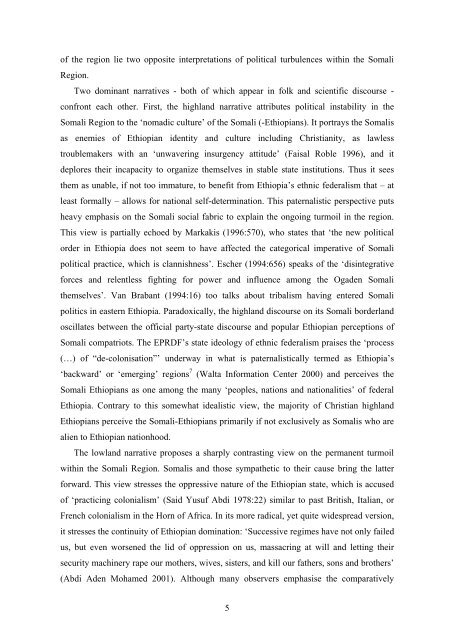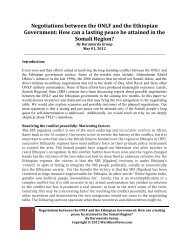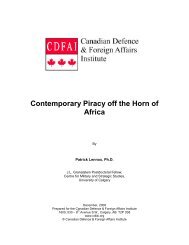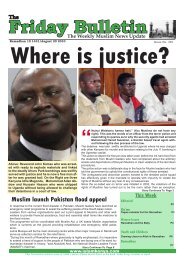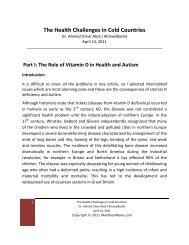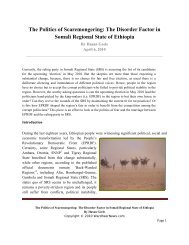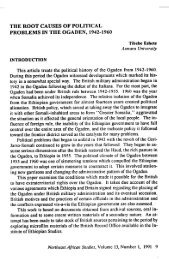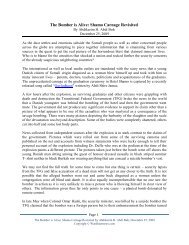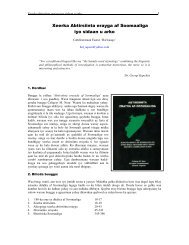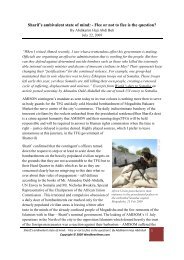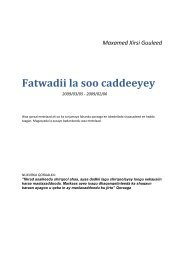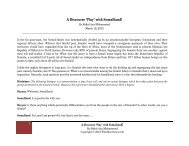View - WardheerNews
View - WardheerNews
View - WardheerNews
You also want an ePaper? Increase the reach of your titles
YUMPU automatically turns print PDFs into web optimized ePapers that Google loves.
of the region lie two opposite interpretations of political turbulences within the Somali<br />
Region.<br />
Two dominant narratives - both of which appear in folk and scientific discourse -<br />
confront each other. First, the highland narrative attributes political instability in the<br />
Somali Region to the ‘nomadic culture’ of the Somali (-Ethiopians). It portrays the Somalis<br />
as enemies of Ethiopian identity and culture including Christianity, as lawless<br />
troublemakers with an ‘unwavering insurgency attitude’ (Faisal Roble 1996), and it<br />
deplores their incapacity to organize themselves in stable state institutions. Thus it sees<br />
them as unable, if not too immature, to benefit from Ethiopia’s ethnic federalism that – at<br />
least formally – allows for national self-determination. This paternalistic perspective puts<br />
heavy emphasis on the Somali social fabric to explain the ongoing turmoil in the region.<br />
This view is partially echoed by Markakis (1996:570), who states that ‘the new political<br />
order in Ethiopia does not seem to have affected the categorical imperative of Somali<br />
political practice, which is clannishness’. Escher (1994:656) speaks of the ‘disintegrative<br />
forces and relentless fighting for power and influence among the Ogaden Somali<br />
themselves’. Van Brabant (1994:16) too talks about tribalism having entered Somali<br />
politics in eastern Ethiopia. Paradoxically, the highland discourse on its Somali borderland<br />
oscillates between the official party-state discourse and popular Ethiopian perceptions of<br />
Somali compatriots. The EPRDF’s state ideology of ethnic federalism praises the ‘process<br />
(…) of “de-colonisation”’ underway in what is paternalistically termed as Ethiopia’s<br />
‘backward’ or ‘emerging’ regions 7 (Walta Information Center 2000) and perceives the<br />
Somali Ethiopians as one among the many ‘peoples, nations and nationalities’ of federal<br />
Ethiopia. Contrary to this somewhat idealistic view, the majority of Christian highland<br />
Ethiopians perceive the Somali-Ethiopians primarily if not exclusively as Somalis who are<br />
alien to Ethiopian nationhood.<br />
The lowland narrative proposes a sharply contrasting view on the permanent turmoil<br />
within the Somali Region. Somalis and those sympathetic to their cause bring the latter<br />
forward. This view stresses the oppressive nature of the Ethiopian state, which is accused<br />
of ‘practicing colonialism’ (Said Yusuf Abdi 1978:22) similar to past British, Italian, or<br />
French colonialism in the Horn of Africa. In its more radical, yet quite widespread version,<br />
it stresses the continuity of Ethiopian domination: ‘Successive regimes have not only failed<br />
us, but even worsened the lid of oppression on us, massacring at will and letting their<br />
security machinery rape our mothers, wives, sisters, and kill our fathers, sons and brothers’<br />
(Abdi Aden Mohamed 2001). Although many observers emphasise the comparatively<br />
5


